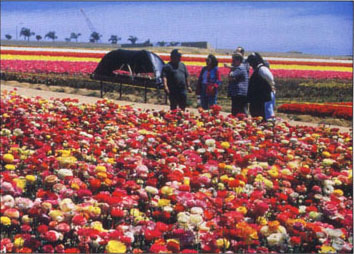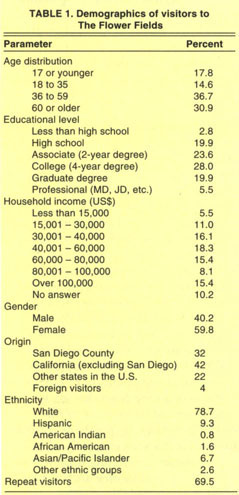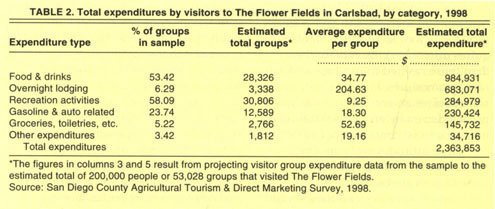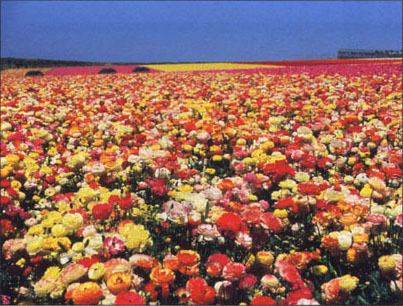All Issues
Agritourism benefits agriculture in San Diego County
Publication Information
California Agriculture 53(6):20-24. https://doi.org/10.3733/ca.v053n06p20
Published November 01, 1999
PDF | Citation | Permissions
Abstract
Agricultural tourism (also known as agritourism and agrotourism) can have significant benefits for farmers and communities in the agricultural-urban interface of San Diego and other metropolitan counties. Results from a visitor study indicate that agricultural tourism has substantial economic impacts on local economies. In addition, agritourism provides opportunities for diversification and economic incentives for growers, promotes economic development and helps educate the public about the important contributions of agriculture to the county's economy and quality of life.
Full text
Tourism and agriculture are big business in San Diego County, ranking second and fourth respectively as the county's largest industries (San Diego County 1999). Current trends in the tourist industry show increasing demand for experiential, hands-on, nonconventional tourism activities. This trend has extended into the agricultural sector because the appeal for agricultural and farm-based tourism attractions is also increasing. The relative importance of local tourism and agricultural industries may result in agritourism becoming an important segment of San Diego County's tourism product mix. In addition to conventional tourism, the county's tourist industry also markets historical and ecological or nature-based tourism. Marketing agritourism as a separate segment of the tourism industry could have substantial benefits for local agriculture.
Agritourism is defined as any business conducted by a farmer for the enjoyment or education of the public, to promote the products of the farm and to generate additional farm income (Hilchey 1993). It includes a variety of facilities and activities that are increasingly available in San Diego County, such as agricultural festivals, farm visits, farm tours, demonstration farms, farm stays, wineries, nursery trails and agricultural museums. In addition, there are more than 20 Certified Farmers' Markets that operate in most incorporated communities of the county. Combining the large tourism industry with the uniqueness and diversity of local agriculture may offer a whole new set of opportunities for farmers to diversify their operations and their revenue sources.
The potential benefits of agritourism for local agriculture are varied. First, agritourism may generate diversification opportunities for local farmers to increase revenues and enhance the viability of their operations. Second, it may be an excellent tool to educate the public about the importance of agriculture and its contribution to the county's economy and quality of life. Third, it may provide economic incentives and reduce friction in the agricultural-urban interface, thus helping to preserve agricultural land in San Diego County. Finally, agritourism may enhance the appeal and demand for local products, foster regional marketing efforts and create value-added and direct-marketing opportunities that may stimulate economic activity and spread the benefits to various communities in the county.
We surveyed visitors to The Flower Fields in Carlsbad, a popular agritourism attraction in San Diego County. The purpose of the study was to improve our understanding of potential consumers for this type of activity and to assess the awareness of visitors about issues that affect local agriculture. The study also helped assess the potential benefits for farmers. Finally, it provided data needed to estimate the economic impact that this type of activity may have on host communities.
The Flower Fields in Carlsbad
San Diego is the second most populous county and the third largest tourist destination in California. The county's 2.8 million residents, combined with the large population in the Southern California/Northern Baja region, constitute a large potential market. This market represents a large portion of the more than 25 million people who visit the county annually (San Diego County 1999). In addition, San Diego County's agricultural industry ranks in the top 10 statewide. It generates nearly $1.2 billion in direct sales and an estimated annual impact of $4.12 billion for the county's economy (San Diego County 1999). However, growth, urbanization, rising water costs, high land prices, competition for resources, increased market competition and other issues present in the agricultural-urban interface have changed local agriculture. The county's agriculture has changed from the production of a few major commodities to a highly diversified, responsive industry that serves not only local needs but national and international markets as well. Nowhere are these changes more evident than in the city of Carlsbad.
The Flower Fields at Carlsbad is a working farm where ranunculus and other flowers are grown for the production of bulbs. As a by-product, the bloom of the ranunculus plants produces a marvelous display of color that attracts thousands of visitors annually. The farm is located in Carlsbad, on a hillside overlooking the Pacific shoreline and surrounded by houses, shopping malls and office buildings. Decreasing profit margins in the bulb-growing operation led The Flower Fields to add a visitor services enterprise to capture revenues from the large number of people attracted to the site. As a result, The Flower Fields opened to the public as an attraction in 1993. Since then, visiting this site has become a tradition for local residents and a popular springtime attraction for travelers to Southern California. The site attracts over 200,000 people annually during the 10-week blooming season and has stimulated economic activity in the area.
The Flower Fields' visitor survey
We administered a survey to visitors of The Flower Fields to gather expenditure information needed to estimate the economic impact of the attraction on the economy of Carlsbad and San Diego County. The survey also helped develop a profile of visitors and assess their awareness of issues that affect agriculture, including production and direct-marketing methods used by growers. We used the questionnaire programming language developed by the U.S. General Accounting Office to create a computer-generated questionnaire, which was administered to visitors through personal interviews. Responses were entered directly into notebook computers. This simplified the sampling process by combining data collection and data entry into one operation, thereby reducing study costs. Between April 15 and April 30, 1998, we collected a total of 543 samples. Samples were collected for every day of the week; however, data collection did not occur on consecutive days. The number of interviews conducted provides a representative sample of visitors to The Flower Fields at the 95% confidence level.
George Manglalan, UCCE farm and home advisor's field assistant, describes research activities to a group of visitors.
Visitors were asked to report their expenditures in the city of Carlsbad as a result of their trip to The Flower Fields. The visitor expenditure data and information collected from the sample survey was projected to represent the 200,000 visitors and was used with the IMPLAN (IMpact analysis for PLANning) economic model to estimate the total economic impact that these expenditures had on the economy of Carlsbad. The IMPLAN model, developed by the U.S. Forest Service, uses a comprehensive and detailed database that covers most economic sectors. It allows users to construct input-output models for geographic areas of any size (at the zip-code level) in the United States. IMPLAN is an excellent tool to evaluate regional and community economic impacts resulting from changes in specific sectors of the economy. The model generates aggregate or sectoral impacts on various measures of economic activity, including output, value added, personal income and employment (Lindall and Olson 1996, Goldman 1996). It is commonly used to analyze the impacts of visitor expenditures and is an appropriate model for our analysis.
Visitor and trip characteristics
According to The Flower Fields records, an estimated 200,000 people visited the site during the spring of 1998, with approximately 150,000 paid admissions. These visitors often traveled in groups, with an average size of 3.77 people per group, for an estimated total of 53,028 visitor groups for the season. Visitors engaged in various activities and visited many tourist attractions in San Diego County, including the San Diego Zoo, the Wild Animal Park, Sea World, Balboa Park, downtown San Diego and several local beaches. Although it is difficult to determine the role that The Flower Fields played in attracting visitors to San Diego County, the study shows that it played a major role in attracting visitors to Carlsbad. Eighty-one percent of survey respondents mentioned The Flower Fields as one of the most important reasons for their trip to Carlsbad. This includes both county residents (local residents) and out-of-county visitors traveling to Carlsbad from other locations in and out of San Diego County. Visitors traveled an average of 132 miles each way to get to The Flower Fields and spent an average of 8 hours in Carlsbad during their trip.
Table 1 shows key demographic characteristics of visitors to The Flower Fields. Comparing this data with the California Office of Tourism data shows that visitors to this attraction are similar to visitors to nonagri-cultural tourist sites in the county. California residents accounted for 74% of all visitors, and most were from Southern California. San Diego County residents accounted for 32% of all visitors and for 42% of visitors from California. About 67% of all visitors were older than 36 years of age, with 36.7% falling between the ages of 36 and 59. Female respondents outnumbered males by a ratio of 1.5 to 1. About 70% of all visitors to The Flower Fields were repeat visitors, and about 70% of these had made between two and five previous visits. Eighty-six percent of visitors indicated they would definitely return to The Flower Fields.
Visitor group expenditures
When the data and information from the survey were projected to all 200,000 visitors to The Flower Fields, the estimated 53,028 visitor groups reported expenditures of $2,363,853 in the city of Carlsbad (table 2). Recreation activities were the most reported expenditure (58% of respondents), followed by food and drink (53.4%) and gasoline and automobile-related (24%). Overnight lodging (6.29%), groceries and toiletries (5.22%) and “;other expenditures” (3.42%) complete the list. In terms of average expenditure per category, overnight lodging was clearly the highest, at $204.63/group, followed by groceries and toiletries at $52.69/group, and food and drink at $34.77/group. Total expenditures per category results show that food and drink account for the largest amount ($984,931), followed by overnight lodging ($683,071).
It is important to note that a large number of the 1,812 visitor groups (3.42% of all groups) that reported “;other expenditures” listed agricultural products among the items they purchased. Although the total amount spent on agricultural products is difficult to quantify, this shows that agritourism may increase sales of agricultural products. This also supports the notion that targeting and educating tourists as consumers may result in substantial marketing opportunities for local farmers. Finally, the 1,812 groups that reported other expenditures spent $19.16/group. This translates into $34,700 in direct expenditures. However, the lack of specific information on these expenditures prevented their use in the model to estimate the economic impact.
Economic benefits and impacts
The study shows that visitors to The Flower Fields have a positive economic impact for the farm operation and for the city of Carlsbad. At the farm level, the estimated 150,000 paid admissions resulted in $600,000 of additional revenue for the operation. Also, the influx of visitors increased direct marketing of ranunculus bulbs and other products grown by the operation or by other local farmers, thereby increasing the profit margins. In addition, the identity and name recognition facilitated the launch of other value-added, revenue-generating activities, including the introduction of a new line of plant material and the sale of souvenirs with the trade name “;The Flower Fields.” Finally, and most importantly, the site has helped educate visitors that local agriculture may enhance the natural beauty and foster economic activity in various communities in San Diego County.
The benefits to the community are also sizable because visitors to The Flower Fields spent an estimated $2,329,137 in Carlsbad ($7,759,356 in San Diego County). However, these figures represent only direct expenditures by visitors. The impact is far greater when the total economic impact on the local community is estimated (table 3). The economic multipliers presented in columns 3 through 6 of table 3 are a numeric representation of the economic impact resulting from the initial visitor expenditures in Carlsbad by visitors to The Flower Fields. The actual impacts are reported in columns 7 through 10. The impacts and economic multipliers were estimated using data and information from the sample survey, along with the 1996 IMPLAN database for the city of Carlsbad at the zip-code level. They are reported using various measures of economic activity.
Output multipliers measure the total effect on industry output and personal consumption expenditures that result from the initial expenditures made by visitors. They also measure the interdependence among various sectors of the economy. The study shows that expenditures made by visitors to The Flower Fields resulted in a total impact of $3,778,653 on the economy of Carlsbad.
The income multiplier measures the total effect of employee compensation, proprietor's income and other property type income. This generates an estimated impact of $2,055,472 for Carlsbad. The value-added multiplier measures employee compensation, proprietary income, other property type income and indirect business taxes. The estimated value-added economic impact is $2,357,741. Finally, the employment multiplier measures the total number of jobs, full-time or part-time, that result. A total of 69 jobs were created in Carlsbad as a result of expenditures made by visitors. This shows that The Flower Fields has a significant economic impact on the economy of Carlsbad, despite being a highly seasonal attraction.
Promoting agritourism
The Flower Fields is a unique attraction in San Diego County. Studying this site helps illustrate the benefits that agritourism may bring for farmers, for agriculture in general and for local communities in San Diego County.
Clearly, agritourism is not for all farmers. Nor will it solve all the problems that affect agriculture in San Diego County. Nevertheless, our study shows that it creates opportunities for diversifying revenue sources and provides economic incentives for some farmers to remain in agriculture. San Diego County's well-established tourist industry, its well-developed infrastructure, its large local and regional market, its mild climate, and its diverse agricultural industry clearly enhance the potential for successful agritourism activities. These results should encourage farmers and communities to promote and develop agriculturally based tourism activities that may become tourist destinations. Capturing the tourist dollars at the farm gate may provide the extra revenues that farmers and host communities need to survive and to foster economic activity on a countywide, year-round basis.
In addition to The Flower Fields, San Diego County has an existing base of agritourism attractions that includes harvest festivals, demonstration farms and Certified Farmers' Markets. However, the potential for agritourism is far greater and largely untapped. Furthermore, as with any economic development activity, coordination and external inputs may be needed to stimulate the farmers and farm-related sectors to exploit these opportunities. Farmers must overcome their traditional views of farming as simply the production of food and fiber. Agritourism involves the exchange of services as well as products. It also requires different skills and abilities than those needed to produce and sell raw commodities. Finally, agritourism also requires an entrepreneurial approach driven by an understanding of market trends, consumer behavior, consumer attitudes and consumer preferences. Our findings indicate that these factors are favorable for agritourism activities and they should inform, lead and shape product development and marketing.
The beauty and color of ranunculus flowers attracts thousands of visitors to The Flower Fields in Carlsbad.
The facilitation, coordination and growth of agritourism as a distinct economic activity requires the emergence of institutions and associations that can coordinate strategic planning, event management, joint promotion, advertising campaigns and information management. Our findings provide important baseline information needed for farmers, local organizations and communities to invest in this process. Public-private partnerships to create infrastructure and support systems are needed to coordinate and to build capacity in the agricultural community. This will improve the sustainability of agritourism by helping farmers become informed, active participants who can deal with emerging issues and capitalize on the opportunities resulting from agritourism.
Financial support for agritourism may come from a variety of sources. Revenues generated from Transient Occupancy Taxes have been used in some areas to support and promote regional agricultural marketing efforts, including agritourism. The County of San Diego, local convention and visitor's bureaus, and agricultural organizations could explore the merits of public-private partnerships that are beneficial to the tourist and agricultural industries. Further diversifying tourism promotional efforts, destinations and attractions to include agritourism may help preserve agricultural land and spread the benefits of tourism. Furthermore, enhancing the economic viability of farming operations and stimulating economic growth and employment opportunities in a wider geographic area may improve the quality of life for residents in the county's ag-urban interface.
Agritourism has many benefits
This study demonstrates that The Flower Fields has a substantial economic impact on the economy of Carlsbad. The results should encourage other communities in the county to support and promote this type of activity. The results are encouraging for the local agricultural industry because agritourism may result in opportunities to diversify their crops, enterprises, marketing methods and revenue sources. Agritourism may provide the economic incentives that growers need to keep their farms viable and to keep their land in agriculture.
The demographics of visitors to The Flower Fields and their willingness to buy local products and to support local growers make this a very large and accessible market. This may allow growers to be innovative and to explore new crops and new marketing methods.
Agritourism can be an effective tool to educate consumers about local agriculture, its issues and its importance for the county's economy and quality of life. Agritourism also showcases the diversity and uniqueness of local agriculture, thereby increasing the visibility and the appeal of locally grown products. This may result in regional marketing programs and public-private partnerships that can support and sustain agriculture and the economic and environmental diversity of San Diego County.









